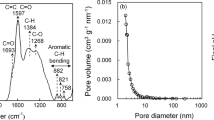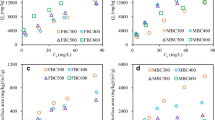Abstract
Pyrolyzing municipal wastewater treatment sludge into biochar can be a promising sludge disposal approach, especially as the produced sludge-derived biochar (SDBC) is found to be an excellent sorbent for heavy metals and atrazine. The aim of this study was to investigate how and why the coexisting humic acids influence the sorption capacity, kinetic, and binding of these contaminants on SDBC surface. Results showed humic acids enhanced Pb(II)/Cr(VI) sorption binding, and increased the corresponding Pb(II) Langmuir sorption capacity at pH 5.0 from 197 to 233 μmol g−1, and from 688 to 738 μmol g−1 for Cr(VI) at pH 2.0. It can be mainly attributed to the sorbed humic acids, whose active functional groups can offer the additional sites to form stronger inner-sphere complexes with Pb2+, and supply more reducing agent to facilitate the transformation of Cr(VI) to Cr(III). However, humic acids reduced the atrazine adsorption Freundlich constant from 1.085 to 0.616 μmol g−1. The pore blockage, confirmed by the decreased BET-specific surface area, as well as the more hydrophilic surface with more sorbed water molecules may be the main reasons for that suppression. Therefore, the coexisting humic acids may affect heavy metal stabilization or pesticide immobilization during SDBC application to contaminated water or soils, and its role thus should be considered especially when organic residues are also added significantly to increase the humic acid content there.

ᅟ



Similar content being viewed by others
References
An J, Jho EH, Nam K (2015) Effect of dissolved humic acid on the Pb bioavailability in soil solution and its consequence on ecological risk. J Hazard Mater 286:236–241
Báez M, Fuentes E, Espinoza J (2013) Characterization of the atrazine sorption process on Aandisol and Ultisol volcanic ash-derived soils: kinetic parameters and the contribution of humic fractions. J Agric Food Chem 61:6150–6160
Cabaniss SE (2008) Quantitative structure—property relationships for predicting metal binding by organic ligands. Environ Sci Technol 42:5210–5216
Chen JP, Wu S (2004) Simultaneous adsorption of copper ions and humic acid onto an activated carbon. J Colloid Interface Sci 280(2):334–342
Chen Q, Wang H, Yang B, He F (2014) The combined effects of atrazine and lead, Pb): relative microbial activities and herbicide dissipation. Ecotoxicol Environ Saf 102:93–99
Christ I, Milne CJ, Kinniburgh DG, Kretzschmar R (2001) Relating ion binding by fulvic and humic acids to chemical composition and molecular size. 2. Metal binding. Environ Sci Technol 35(12):2512–2517
Dong HR, Lo IMC (2013) Influence of humic acid on the colloidal stability of surface-modified nano zero-valent iron. Water Res 47:419–427
Dupont L, Guillon E (2003) Removal of hexavalent chromium with a lignocellulosic substrate extracted from wheat bran. Environ Sci Technol 37:4235–4241
Elangovan R, Philip L, Chandraraj K (2008) Biosorption of hexavalent and trivalent chromium by palm flower (Borassusaethiopum). Chem Eng J 141:99–111
Han Z, He G, Wang J, Lv C (2011) Joint toxic effects of heavy metals and atrazine on invasive plant species Solidago Canadensis L. Chin J Geochem 30:523–530
He Z, Ohno T, Cade-Menun BJ, Erich MS, Honeycutt CW (2006) Spectral and chemical characterization of phosphates associated with humic substance. Soil Sci Soc Am J 70:1741–1751
Hsu NH, Wang SL, Lin YC, Sheng GD, Lee JF (2009) Reduction of Cr (VI) by crop-residue-derived black carbon. Environ Sci Technol 43:8801–8806
Joo JC, Shackelford CD, Reardon KF (2008) Sorption of nonpolar neutral organic compounds to humic acid-coated sands: contributions of organic and mineral components. Chemosphere 70:1290–1297
Krishnani KK, Meng X, Christodoulatos C, Boddu VM (2008) Biosorption mecha- nism of nine different heavy metals onto biomatrix from rice husk. J Hazard Mater 153:1222–1234
Kwon S, Pignatello JJ (2005) Effect of natural organic substances on the surface and adsorptive properties of environmental black carbon (char): pseudo pore blockage by model lipid components and its implications for N2-probed surface properties of natural sorbents. Environ Sci Technol 39:7932–7939
Lamelas C, Pinheiro JP, Slaveykova VI (2009) Effect of humic acid on Cd(II), Cu(II), and Pb(II) uptake by freshwater algae: kinetic and cell wall speciation considerations. Environ Sci Technol 43(3):730–735
Lammers K, Arbuckle-Keil G, Dighton J (2009) FTIR study of the changes in carbohydrate chemistry of three New Jersey pine barrens leaf litters during simulated control burning. Soil Biol Biochem 41:340–347
Lima DL, Schneider RJ, Scherer HW, Duarte AC, Santos EB, Esteves VI (2010) Sorption–desorption behavior of atrazine on soils subjected to different organic long-term amendments. J Agric Food Chem 58:3101–3106
Lin DH, Tian XL, Li TT, Zhang ZY, He X, Xing BS (2012) Surface-bound humic acid increased Pb2+ sorption on carbon nanotubes. Environ Pollut 167:138–147
Lu J, Li Y, Yan X, Shi B, Wang D, Tang H (2009) Sorption of atrazine onto humic acids (HAs) coated nanoparticles. Colloids Surf A Physicochem Eng Asp 347:90–96
Lu HL, Zhang WH, Yang YX, Huang XF, Wang SZ, Qiu RL (2012) Relative distribution of Pb2+ sorption mechanisms by sludge-derived biochar. Water Res 46:854–862
Miretzky P, Cirelli AF (2010) Cr(VI) and Cr(III) removal from aqueous solution by raw and modified lignocellulosic materials: a review. J Hazard Mater 180(1–3):1–19
Orsetti S, Marco-Brown JL, Andrade EM, Molina FV (2013) Pb(II) binding to humic substances: an equilibrium and spectroscopic study. Environ Sci Technol 47:8325–8333
Pandey AK, Pandey SD, Misra V (2000) Stability constants of metal-humic acid complexes and its role in environmental detoxification. Ecotoxicol Environ Saf 47:195–200
Pang L, Liu J, Yin Y, Shen M (2013) Evaluating the sorption of organophosphate esters to different sourced humic acids and its effect on the toxicity to Dophnia Magna. Environ Toxicol Chem 32(12):2755–2761
Pignatello JJ, Kwon S, Lu Y (2006) Effect of natural organic substances on the surface and adsorptive properties of environmental black carbon (char): attenuation of surface activity by humic and fulvic acids. Environ Sci Technol 40:7757–7763
Rees F, Simonnot MO, Morel JL (2014) Short-term effects of biochar on soil heavy metal mobility are controlled by intra-particle diffusion and soil pH increase. Eur J Soil Sci 65:149–161
Sag Y, Aktay Y (2000) Mass transfer and equilibrium studies for the sorption of chromium ions onto chitin. Process Biochem 36:157–173
Sibley SD, Pedersen JA (2008) Interaction of the macrolide antimicrobial clarithromycin with dissolved humic acid. Environ Sci Technol 42:422–428
Smith KM, Fowler GD, Pullket S, Graham NJ (2009) Sewage sludge-based adsorbents: a review of their production, properties and use in water treatment applications. Water Res 43:2569–2594
Suksabye P, Nakajima A, Thiravetyan P, Baba Y, Nakbanpote W (2009) Mechanism of Cr(VI) adsorption by coir pith studied by ESR and adsorption kinetic. J Hazard Mater 161:1103–1108
Terdkiatburana T, Wang S, Tadé MO (2008) Competition and complexation of heavy metal ions and humic acid on zeolitic MCM-22 and activated carbon. Chem Eng J 139:437–444
Turner GSC (2013) Chapter 9: Kinetic signature and lability of uranium in the presence of humic acid. In: The application of the passive sampling technique diffusive gradients in thin-films (DGT) to the measurement of uranium in natural waters. Dissertate of PhD, University of Portsmouth, pp: 256–286
Wang XS, Chen LF, Li FY, Chen KL, Wan WY, Tang YJ (2010) Removal of Cr (VI) with wheat-residue derived black carbon: reaction mechanism and adsorption performance. J Hazard Mater 175:816–822
Wang KH, Meng Y, Zou JY, Li G (2012) Status and countermeasures of the sludge treatment and disposal in municipal sewage treatment plants (in Chinese). China Resour Compr Util 30:44–46
Weber WJ, Morris GC (1962) Removal of biologically-resistant pollutants from waste waters by adsorption. In: Advances in water pollution research, Proc 1st Int Conf on Water Pollution Res. Pergamon Press, New York, pp 231–266
Wei T, Zhang P, Wang K, Ding R, Yang B, Nie J, Jia Z, Han Q (2015) Effects of wheat straw incorporation on the availability of soil nutrients and enzyme activities in semiarid areas. PLoS One 10(4), e0120994. doi:10.1371/journal.pone.0120994
Witwicki M, Jerzykiewicz M, Jaszewski AR, Jezierska J, Ozarowski A (2009) Influence of Pb(II) Ions on the EPR properties of the semiquinone radicals of humic acids and model compounds: high field EPR and relativistic DFT studies. J Phys Chem A113:14115–14122
Zhang FS, Itoh H (2005) Iron oxide-loaded slag for arsenic from aqueous system. Chemosphere 60:319–325
Zhang WH, Zhuang LW, Yuan Y, Tong LZ, Tsang DCW (2011) Enhancement of phenanthrene adsorption on a clayey soil and clay minerals by coexisting lead or cadmium. Chemosphere 83(3):302–310
Zhang W, Mao S, Chen H, Huang L, Qiu R (2013) Pb(II) and Cr(VI) sorption by biochars pyrolyzed from the municipal wastewater sludge under different heating conditions. Bioresour Technol 147:545–552
Zhang F, Du N, Li H, Liang X, Hou W (2014) Sorption of Cr(VI) on Mg–Al–Fe layered double hydroxides synthesized by a mechano-chemical method. RSC Adv 4:46823–46830
Zhang W, Zheng J, Zheng P, Tsang DCW, Qiu R (2015a) Sludge-derived biochar for As(III) removal/immobilization: effects of solution chemistry on sorption behavior. J Environ Quality (in press)
Zhang W, Zheng J, Zheng P, Qiu R (2015b) Atrazine immobilization on sludge derived biochar and the interactive influence of coexisting Pb(II) or Cr(VI) ions. Chemosphere (in press)
Zheng W, Liang L, Gu B (2012) Mercury reduction and oxidation by reduced natural organic matter in anoxic environments. Environ Sci Technol 46:292–299
Acknowledgments
The authors wish to thank the National Natural Science Foundation of China (project no. 41272383 and 41225004) and the Guangzhou Municipal Science and Technology Plan Project (contract No: 2012J2200020) as well as the Fundamental Research Funds for the Central Universities for the financial support to this study.
Author information
Authors and Affiliations
Corresponding author
Additional information
Responsible editor: Hailong Wang
Electronic supplementary material
Below is the link to the electronic supplementary material.
ESM 1
(DOC 494 kb)
Rights and permissions
About this article
Cite this article
Zhou, F., Wang, H., Fang, S. et al. Pb(II), Cr(VI) and atrazine sorption behavior on sludge-derived biochar: role of humic acids. Environ Sci Pollut Res 22, 16031–16039 (2015). https://doi.org/10.1007/s11356-015-4818-7
Received:
Accepted:
Published:
Issue Date:
DOI: https://doi.org/10.1007/s11356-015-4818-7




